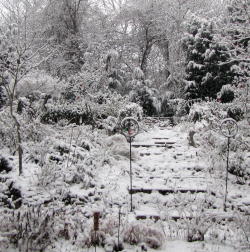
Ideas have been swirling of late in the now muted-color-topped cerebrum, it is beginning to match the dried leaves. Ideas of all sorts float around in there, but many involve the garden, pondering how to improve the overall look, particularly in the late fall blending into winter season. Above, Rosa ‘Moonlight’ in the sky with diamonds, er make that dogwood buds and silver maple branches.

There is no lasting snow cover here. When and if there is a white blanket that so enhances evergreen and hardscape, it melts quickly. The image is from March 2008.

What we do have is lasting leaf cover around the ever expanding multitrunk silver maple. This tree was professionally given a drastic haircut during the initial home and garden renovation in 2000. The multi trunks included more trees than just the maple. Hackberries had cozied up dancing trunk to trunk and were removed. The remaining stumps were drilled with holes and weed killer was poured into those depressions full strength to hasten their demise. The use of these chemicals has long since stopped, but it worked. Other stumps were ground down by a massive machine to a foot or more below soil level, churning soil and chip into a casserole of goodness for plant roots. What was left was a nice pile of woodchips and a cleared hill just to the left of the pruned maple. It was early fall and good neighbor Mae called me over to dig a piece of each cultivar of daylily growing in her garden. Plastic grocery bags were labeled with permanent markers with the names copied from the metal tags stuck in the ground by each patch as we carefully dug. “Put your butt into it!” she said to me. She had heard me say that to offspring Semi when she was helping me plant the liriope rows along the front curbside and thought it hilarious. Well ladies, we do know from whence our strength emanates.

There were twenty five bags filled with large root clumps when we finished. Not sure where to place them, the blank hill of freshly ground woodchips seemed the logical choice. Pale buff colored bricks found on the property were used to identify each daylily, painted with the names as they were planted in a neat grid of rows. The paint used was nail polish of all colors, also found on the property, this time inside the house as it seems Miss Semi had, and still has a thing about painting her finger and toe tips on a nearly daily basis. As a word to the wise, while pretty and cheap, nail polish does not last more than a few months in the elements. Other labeling methods have been tried and the perfect one has yet to be found.

That was quite a detour from the intended topic, sorry. Now you know the origins of the daylily hill. Where were we? Ah, designing for the drab months of the year, it is flowing back now. The point of the paragraph above was to explain the situation that there is one area of fallen leaf duvet comforter while the remaining gardens are without any such desirable protective cover at all. Let us study the first gardens tackled when we moved back to Tennessee in 2000, the steep slope behind the main house. (I am aware that this year has already been mentioned but am trying to help some readers stay with the narrative.)

After being cleared and terraced with the backhoe brought in to dig the foundation for the main house addition, groundcovers were planted to help with erosion control over the entire north facing slope behind the main house. Many happened to be evergreen and added welcome color and interest in winter.

Duking it out are various dianthus, ajuga, golden creeping lysimachia, cerestium, creeping thymes and the deciduous but thuggish wild violets that simply cannot be eradicated no matter the thousands of hours spent trying to do so, among others. Constant rearranging was done to make the view more interesting. What is that blue flowering plant in the center of the above image, you might be thinking?

Reddish hued heucheras and Euphorbia dulcis ‘Chameleon’ add jeweltones to the palette. Hellebores have colonized the hillside and are quite welcome with their larger dark green leathery finger shaped foliage. Mulching the hill, while somewhat expensive is necessary as heavy rains often will expose the roots of groundcovers and larger plantings, even the trees, dogwoods and Japanese maples. But mulching groundcovers is tricky business. Too thickly applied and the low growers will be suffocated, not enough and the roots are still bared to the occasional sunshine, never helpful for herbacious health.

Whilst determining the exact amount of mulch to use, much of the colorful tapestry is lost to the monotone of the soil enriching additions. (For those interested, the mulch we use is called soil conditioner, finely ground pine bark). The brown and grey leaf cover by the silver maple is also mulched. The solution to the sea of brown has been the addition of evergreen grasses and their close relatives, specifically Nasella tenuissima, assorted Carex, Blue fescue and Acorus. Golden yellows, blues and tans are embroidered throughout the hillside. Movement and dimension from the grasses add spice and animation to the landscape. The trees and shrubs of the hillside planting are the backbone, the skeleton helping to hold the soil in place and giving structural geometry in all seasons. The aforementioned dogwoods and maples are joined by azaleas, roses, fothergillas, flowering quinces, blue star junipers, heaths and hypericums among others. This seems like a motley crew, and it is, but these original plantings have been tweaked and edited until they are now pleasing to the eye and and cohabitating without major breakouts of botanical violence. There is artful, sometimes, and disastrous, occasionally, pruning done to maintain the right balance and light exposure for the underling plantings. Self seeding, unforseen spreading and even demises have continued to make the hilly garden constantly changing with little more than observation by the gardener for the plantings that make up the ecosystem. These plant selections are what works here in zone 7a southeast Tennessee on a sharply draining clay based acid soil. It is hoped that these selections might be helpful to both new and experienced gardeners working with their own diverse conditions. Results, as we all know, vary.

Other areas of the Fairegarden are still much more a work in progress. The aforementioned daylily hill, just outside the realm of the steep slope is constantly fiddled with. A couple of posts on this topic can be seen by clicking here and here. To have interest after the daylilies have finished blooming has proven to be an onerous task. The growing shade of the maple, oh yes that is why we told the story of the severely pruned maple, it all is rushing back into the cerebral folds now, is affecting what can be grown on the once sunny spot. The maple was slow to regrow its canopy with the drought years that followed its harsh haircut, allowing sun loving plantings to thrive underneath. That is changing rapidly now, as can be foretold in the crystal ball of foggy leaf cover. There are so many more leaves on the deck and paths, not to mention on the gardens where they are left to biodegrade this year. More leaves translates to more shade. That’s what trees do isn’t it, provide ever more shade unless catastrophic conditions cause the tree to die and then there is blazing sudden sunlight, as in the case of poor Ferngully, RIP. Plantings need to be adjusted as the light changes.

Come spring, garden interest is not a problem.
~~~
Next time kiddies, we will explore further the many variations of plantings on the daylily hill, for there is enough to digest for one posting here already, as I see by the word count at the bottom of the drafting page. Winter is an excellent time to ponder design, along with life the universe and everything.
Frances
In an abupt change of style, this post was written text first with the images added afterwards. It seems all crazy and mixed up, even with captions inside the photos. I like it!
F









I adore your garden, Frances!!! =)
It gives me a feeling of peace and I like a lot as you have prepared it and furnished.
Have a lot of plants that I also like they and that am introducing recently, in alone garden having understood by now that they withstand even if Sardinia is almost Africa!
Very beautiful that stairway with the Ajuga (?) along the edges and the grey pillows of Straw (?) Lavender (?)
I have noticed that also you like me uses a carpet of dry leaves to protect the roots of the plants from the cold and to oppose the infesting ones.
I admire a lot your gardening way and I think that I will concern me many old men post to also see it in spring!
Good day!
Tiziana
Frances, I always love seeing the older photos of your garden. Whenever I look at mine, and it seems so sparse, I just think, time, time, that is all that is needed.
I have a ton of leaves,(could certainly send you some) so I think that I need more colourful evergreen plants. The garden seems to be a sea of brown and tan now, however it won’t be long until it is black and white.
Deborah
Frances, I lovely post – your slope is always of interest to me as my front garden is on a slope, but sloping the same way as our bungalow and narrow. Challenges, challenges!
Best wishes Sylvia (England)
Hi Frances, I have enjoyed your tour over the slope. I have thought about your slope when I walk through the neighborhood as there are a couple of back yards near here that could use your tutelage. I just love your approach to keeping your slope looking like a proper garden.
What are the bright red things in the last photo?
Just beautiful. The dusting of snow is a wonderful sight. (in your garden) i am learning so much from you for our sloped yard. The one sentence that really pops out at me is, Results, as we all know, vary. Garden tags, I have those metal ones that come with the wax pencil….the writing has stayed since last winter and they don’t stick out at you like a sore, ‘green thumb.’
Frances the tour and history was very interesting to see! You’ve done a wonderful job with your garden. I especially like the close-ups of the plantings on and around the stair steps. I have found gardening on a slope, even a small one, to be challenging.
Frances,
Your garden is so pretty in every season! I like those steps and they don’t look treacherous like some in my garden that need working on. Another project! thanks for the tips and for sharing your ideas.
Your slope is so beautiful. In every season. I am a little jealous of the drama of your site. We are on a slope, but not a SLOPE! I suspect your Thanksgiving was joyous. Here at the End of the Road our celebration continues, but with the beginning of my 2nd Blogoversary celebration. Come visit.
Hi Frances,
A garden is never finished, is it? I look forward to your next installment and I think your writing first and inserting photos definitely works, although I like your posts the old way too :0)
Ruminations on a sloping garden. Now you know I have the same challenge with quite a bit more shade to deal with. Plus I will be looking down the slope. That could change everything. But paths, I must have wide ample structured paths not the current cow trails.
I live in Seattle. Blessedly mild zone 8 winters, but DAMN, they are grey. I must have winter color or I’ll go mad. I have Acer x conspicuum ‘Pheonix’ with bright red bark, Acer circinatum ‘Pacific Fire’ with duller red bark, Cornus sanquinea ‘MIdwinter Fire’ with bark shading from yellow at the center, through orange, to red at the tips. For flowers I have various Cyclamen, Mahonia x ‘Charity’, and Camellia sasanqua ‘Yuletide’. There are also winter blooming heathers (Erica),and heathers (Calluna) that turn fabulous reds, oranges, and bronzes for winter color. Rhododendron ‘Ebony Pearl’ has interesting twisty red leaves. I have sacrificed some spring and summer color to my need for winter color, but it is worth it. For summer color I can always have pots.
Hi Frances! I hope you enjoyed a wonderful Thanksgiving with family and/or friends! I so enjoy “walking” through peoples’ gardens. You have provided such a nice tour. 🙂 I cannot begin to identify with anyone that still has green, flowering plants at this time of year, though. ha. Have a great weekend!
Thanks for showing us your hillside garden! I have my own 40 foot long slope I am tackling, and yours is inspirational. It would be nice if we had just a little snow this year, so I could get some pretty snow-covered garden photos like yours.
Hi Frances, you know I adore your slope in every season. Even with the snow cover it looks great! And all those wonderful plantings you’ve made brings so much inspiration to me. I’m always looking forward to your next post / kram gittan
I loved the photo of the snow. What a beautiful, serene scene. How lucky you are to have such a lovely view even in winter when a lot of plants either die or become dormant.
I enjoyed your post Frances and have the notebook out. My garden is sadly lacking in autumn/winter interest so this is one issue I will be ruminating over this winter. I wish that I had a neighbour like Mae 🙂
As always, Frances, I enjoy reading about the development and changes in design in your gardens. I don’t have any slopes to garden on, but if I did I would surely take note. Of course, there’s still a lot of interesting info here…I do appreciate the explanation of the soil conditioner; I always wondered about that.
I think Semi, at least in her younger days, and Youngest Daughter would get along great. YD includes manicures and pedicures as a “necessity” in her budget:)
I remember reading some literary criticism about an author, perhaps Lord Byron, saying that the digressions in his writing were what made it great. Your digressions, Frances, are what turn a little food for thought into a gourmet meal!
It is such fun to see how an area of garden develops over time. The before and after pictures are great, as are the ideas you used in planning.
wonderful job on your hillside garden– you’ve given me a few ideas — I’ve also got a hill out back only mine is south-facing. I especially like your steps — and the way the plants are tucked in-between!
This definately is the time of year to make plans for next season.
One thing’s for sure, the garden’s never static. It’s always changing as the trees dictate.
gardening on a slope can be a real advantage, but I bet it didn’t feel like that at the start.
That has to be the most scenic stairway to heaven that I’ve ever seen! 🙂
I loved that 5th photo ( well the others too but this one tugged at me)
It’s always fun to tour your garden, even if only by way of computer. Your slopes are much more of a challenge than mine; your violets are about as annoying as my oxalis. It is much more interesting to garden amongst challenges than in a flat rectangle without character or characters.
Frances, I’ve really enjoyed reading this post and the comments on it. My interest is photographic in particular, and I’ve looked and looked… You break all the rules of tidyness (because messyness shows in a photo like it doesn’t in real life) and focal points (because a photo must always be of SOMETHING), yet your photos are absolutely awesome. Why, I ask. Here are some observations. Could Frances the Photographer please comment further. Tremendous clarity and depth of field; close foreground detail; intense colour saturation so that subtle changes show. This would indicate (1) low f-stop (2) high pixel count and top quality lens (3)pushing the saturation during processing. 1 and 2 are camera functions, both of which my Canon S2 fall short on. So what camera do you use? It would seem a good D-SLR? (You see, I’m actually writing this to pursuade my chief Christmas present buyer – myself – what I need for Christmas ;)…) Please comment on your camera and photographic priorities. Also on how you got your blog to be so wide. What is the physical size (pixel width) and the quality (KB count) of your average photo-load? Sorry, this is all very cheeky, but I know you enjoy educational blogs, so please educate us! And if you have already done so, please point me towards it. In envy, but with thanks: Jack